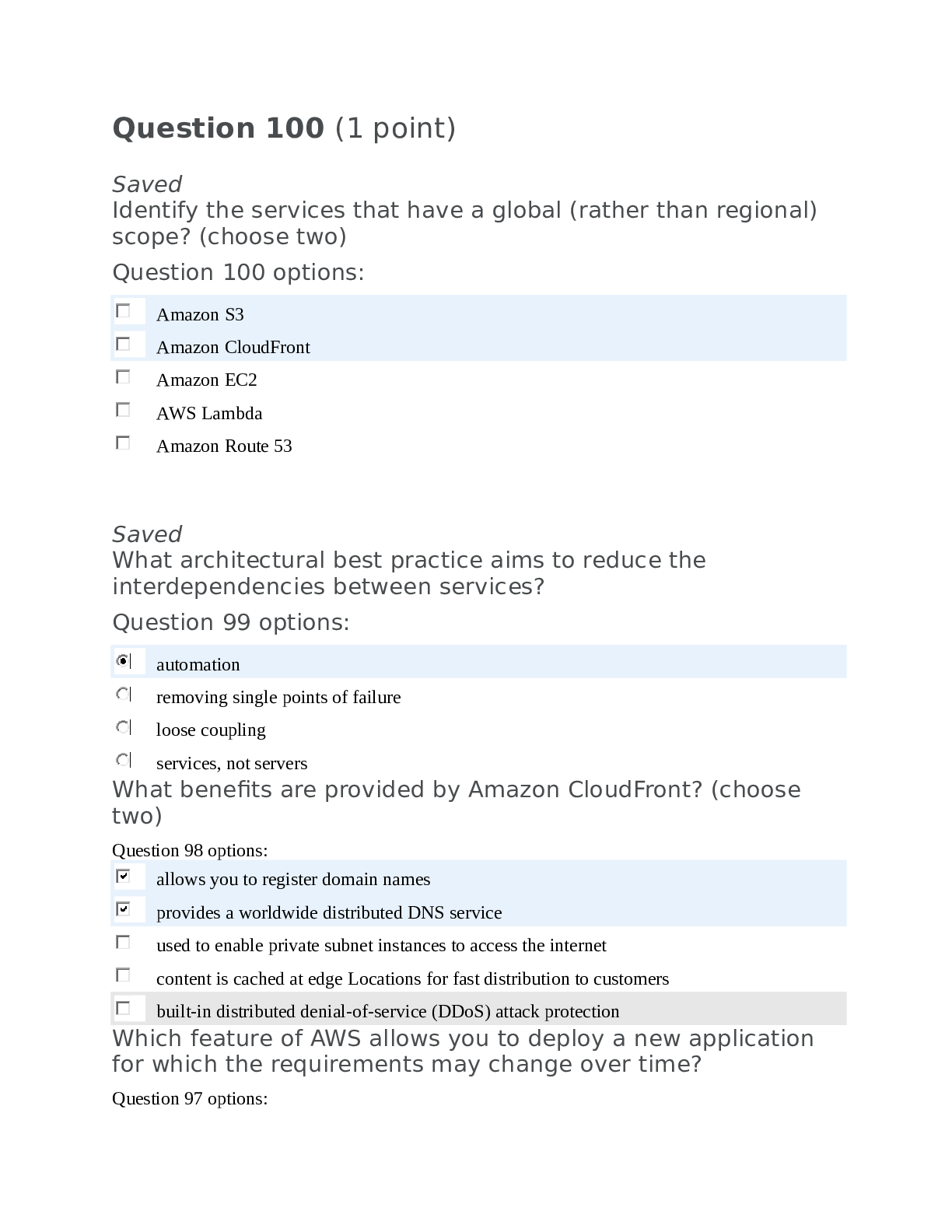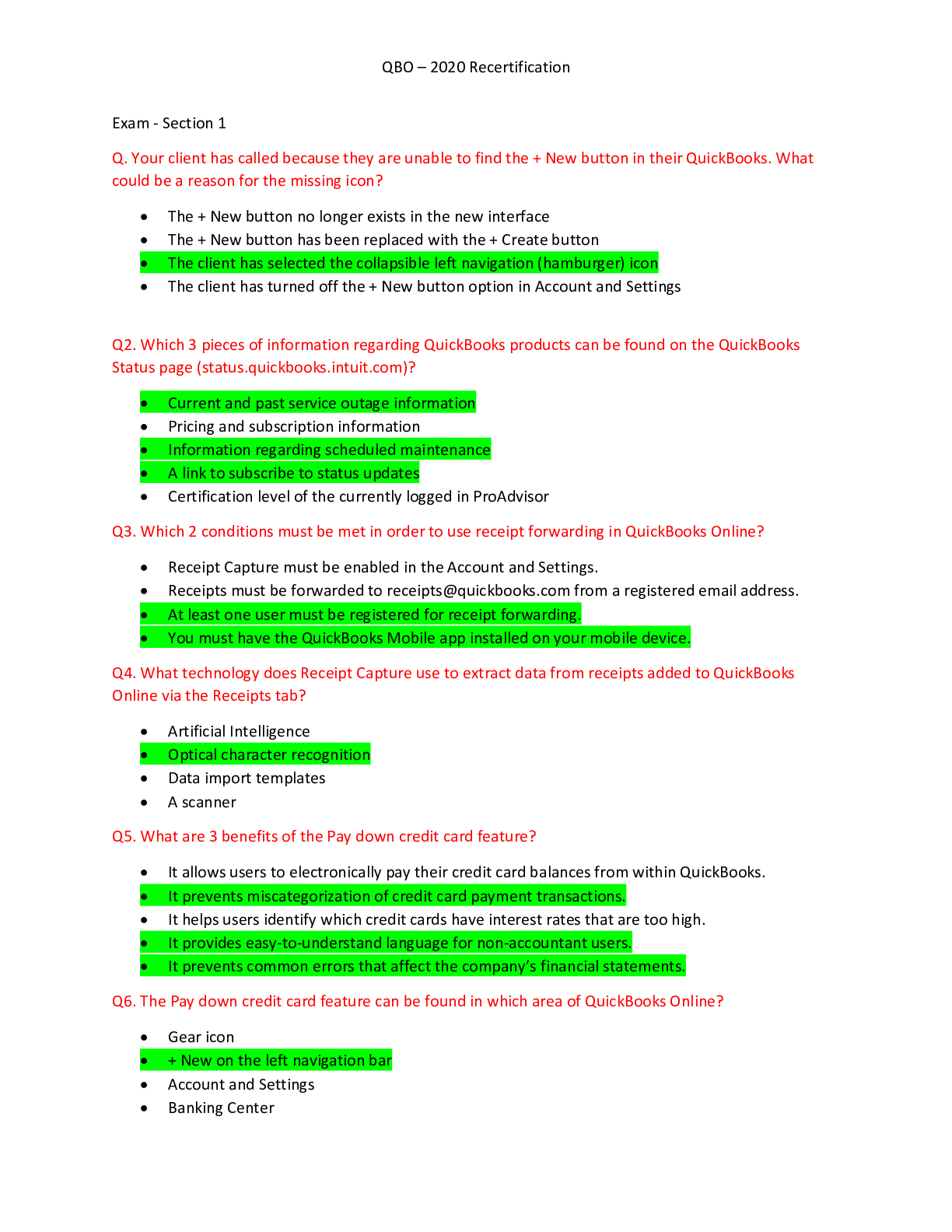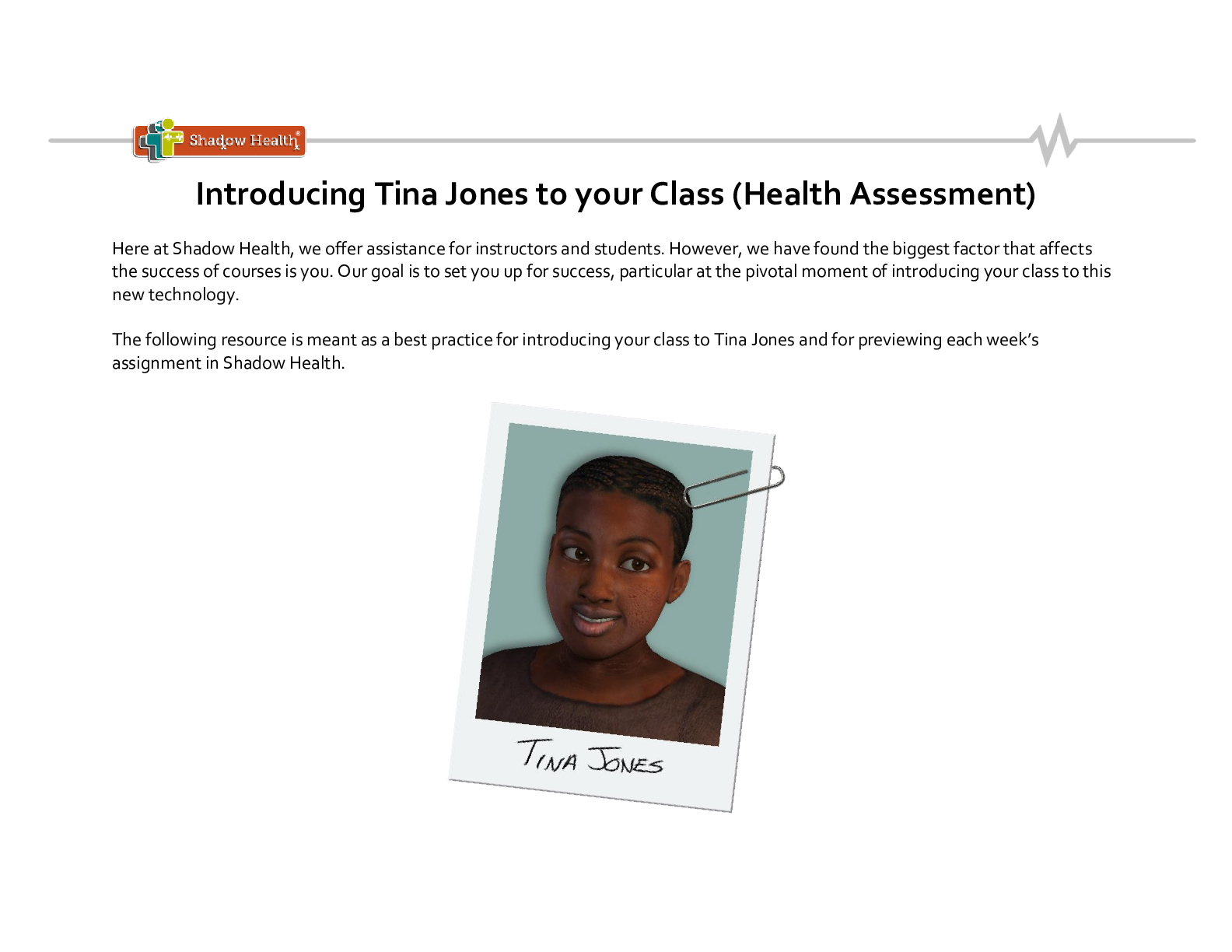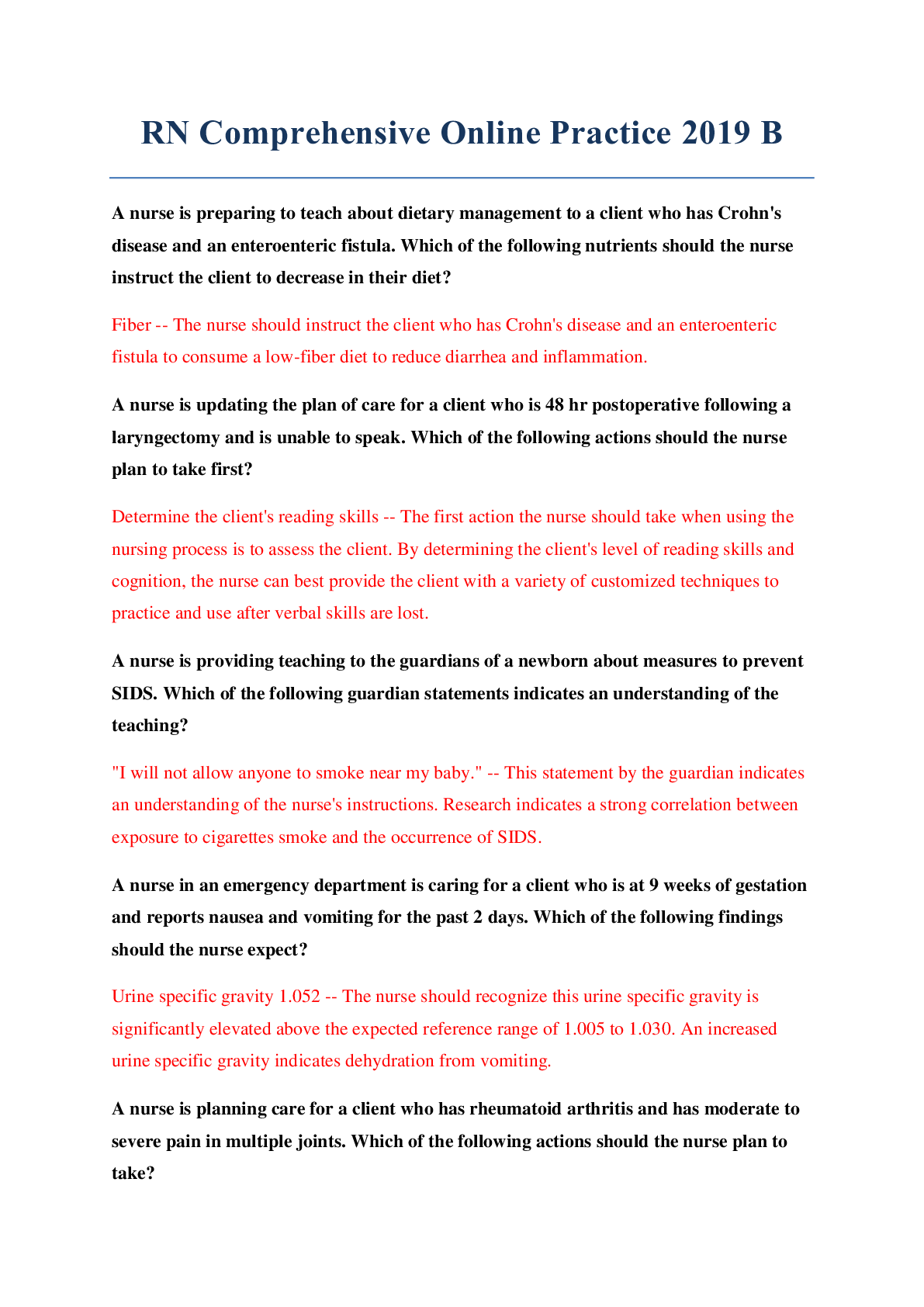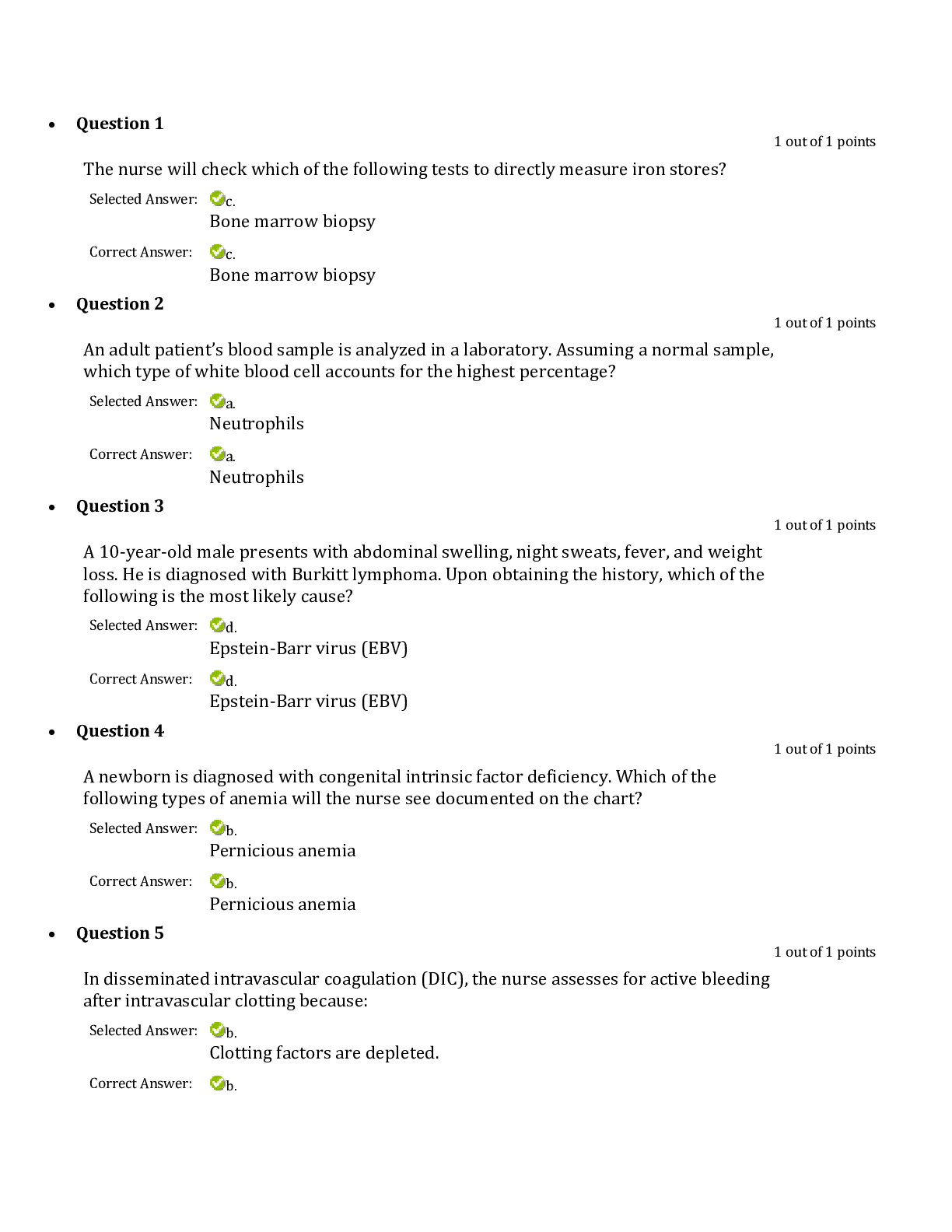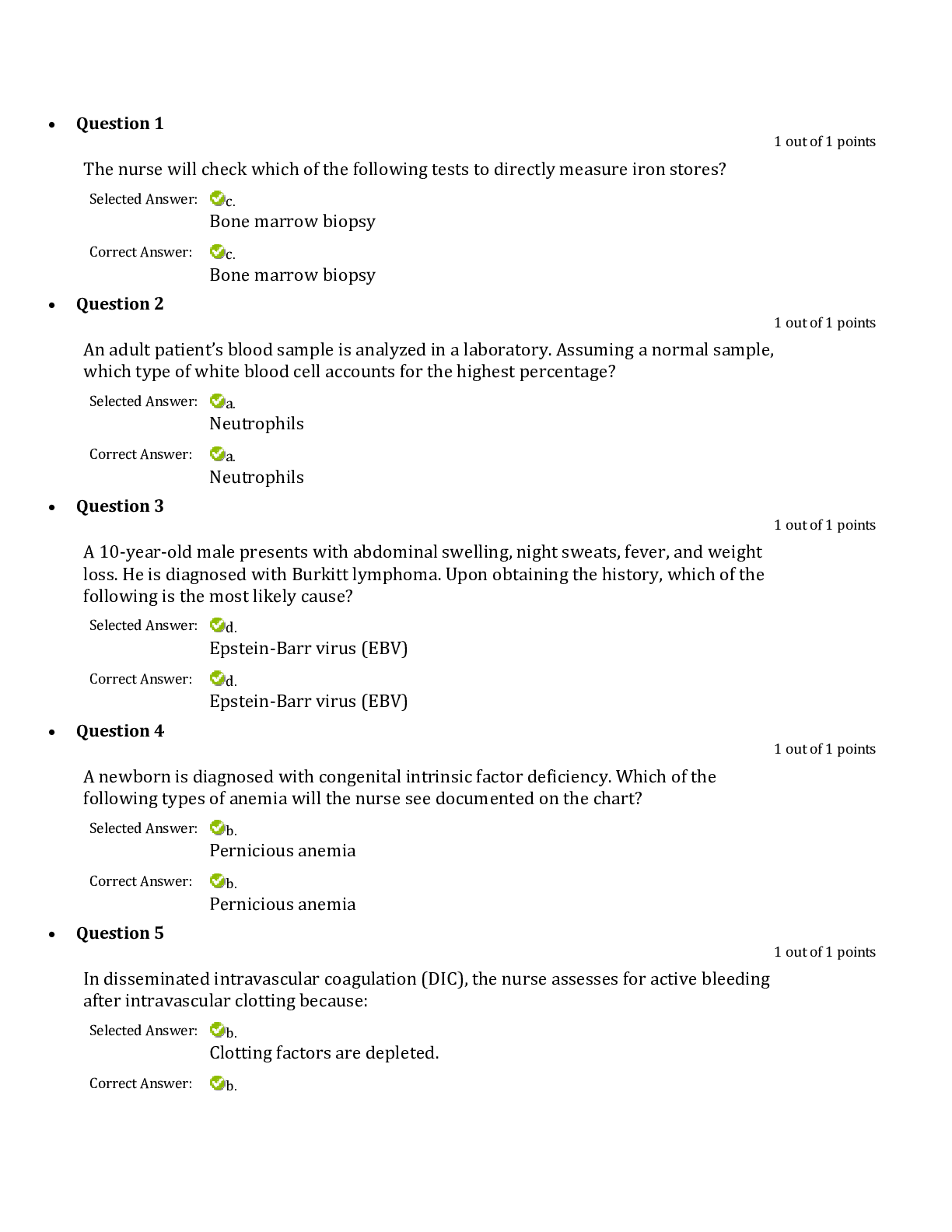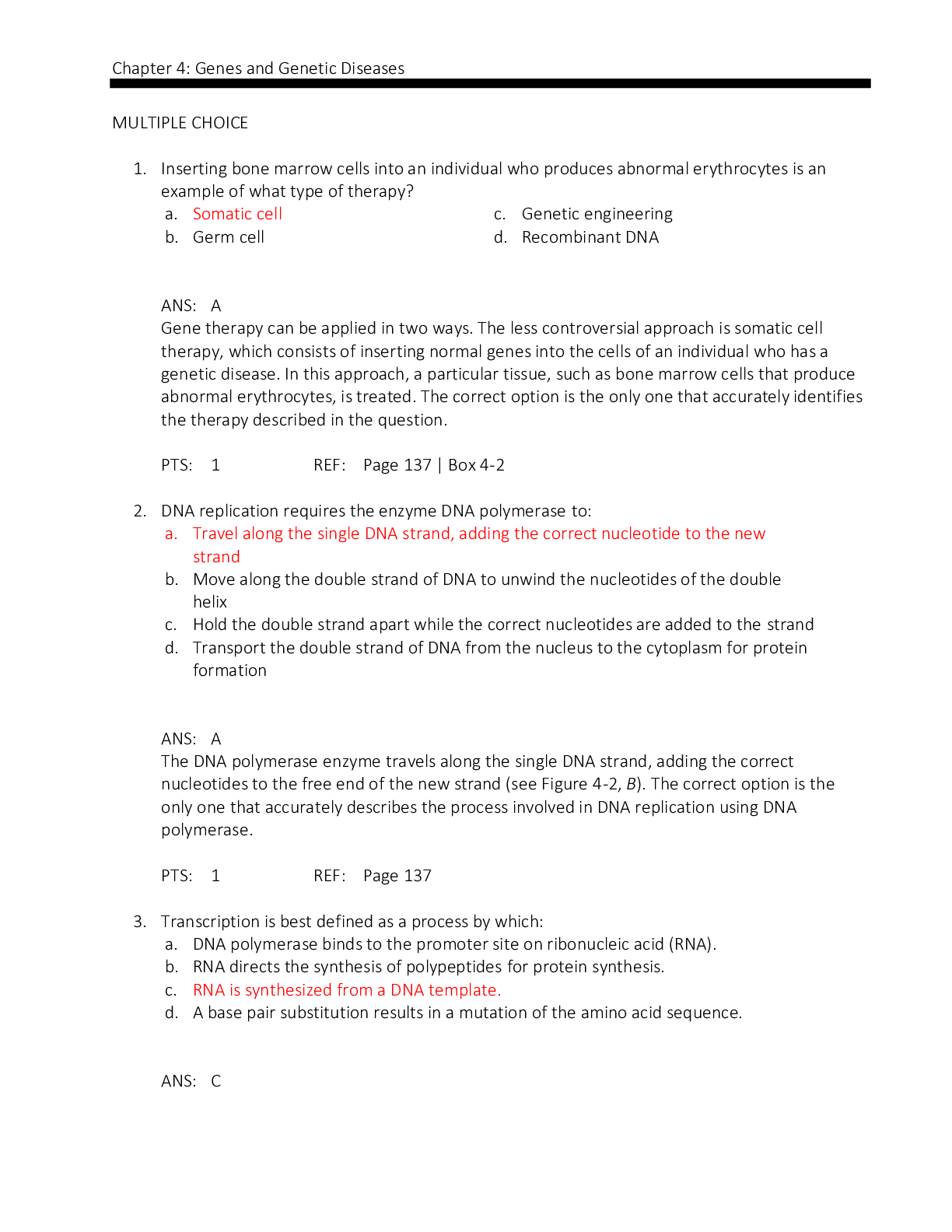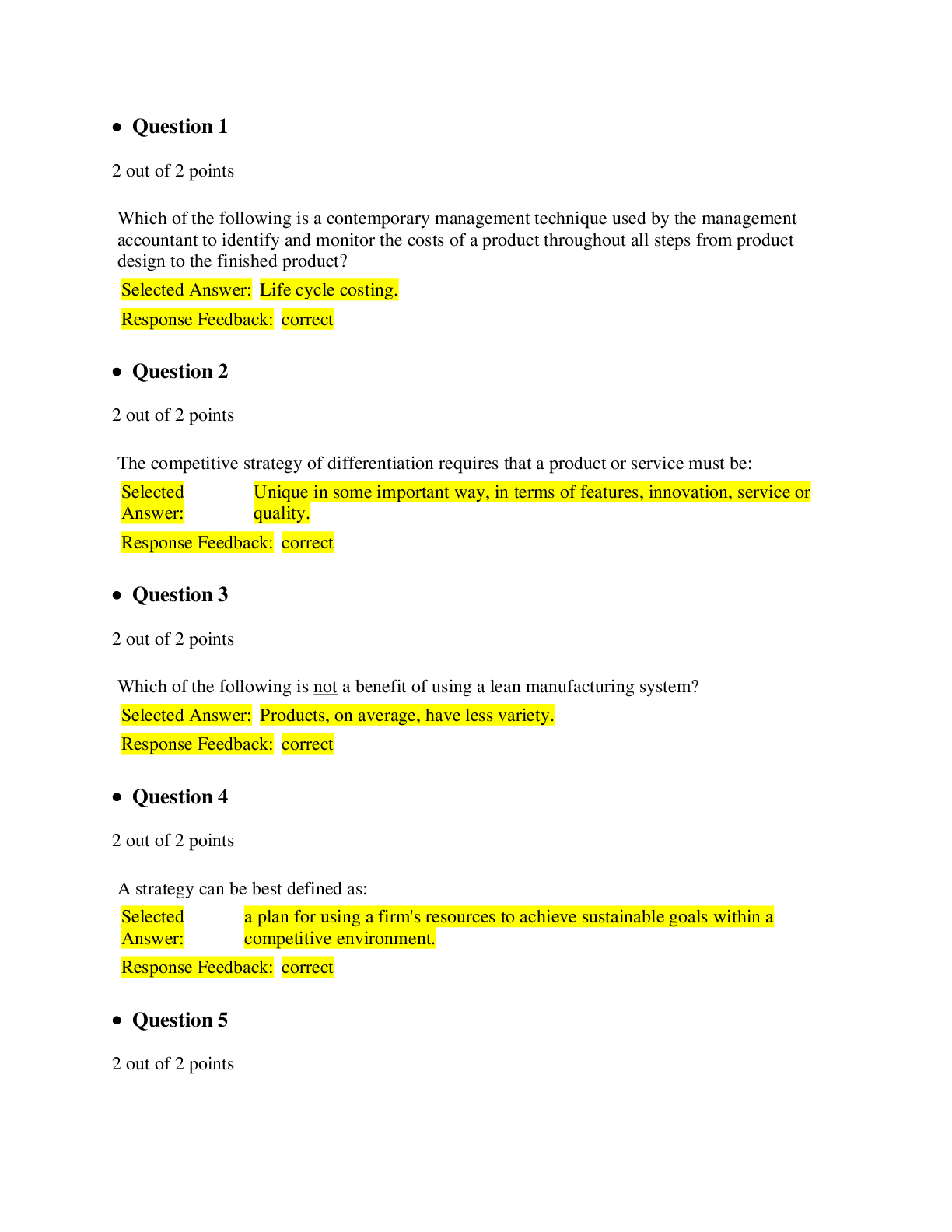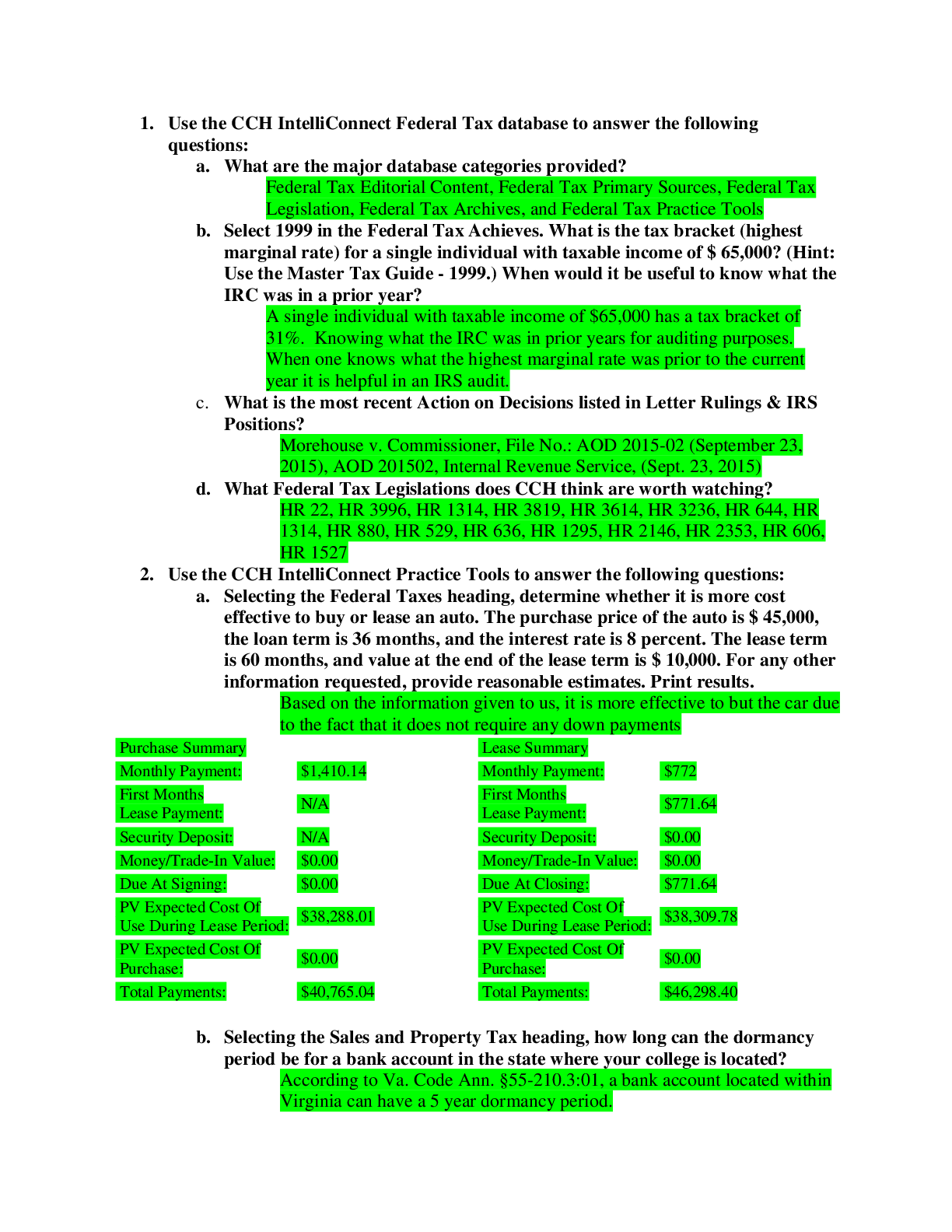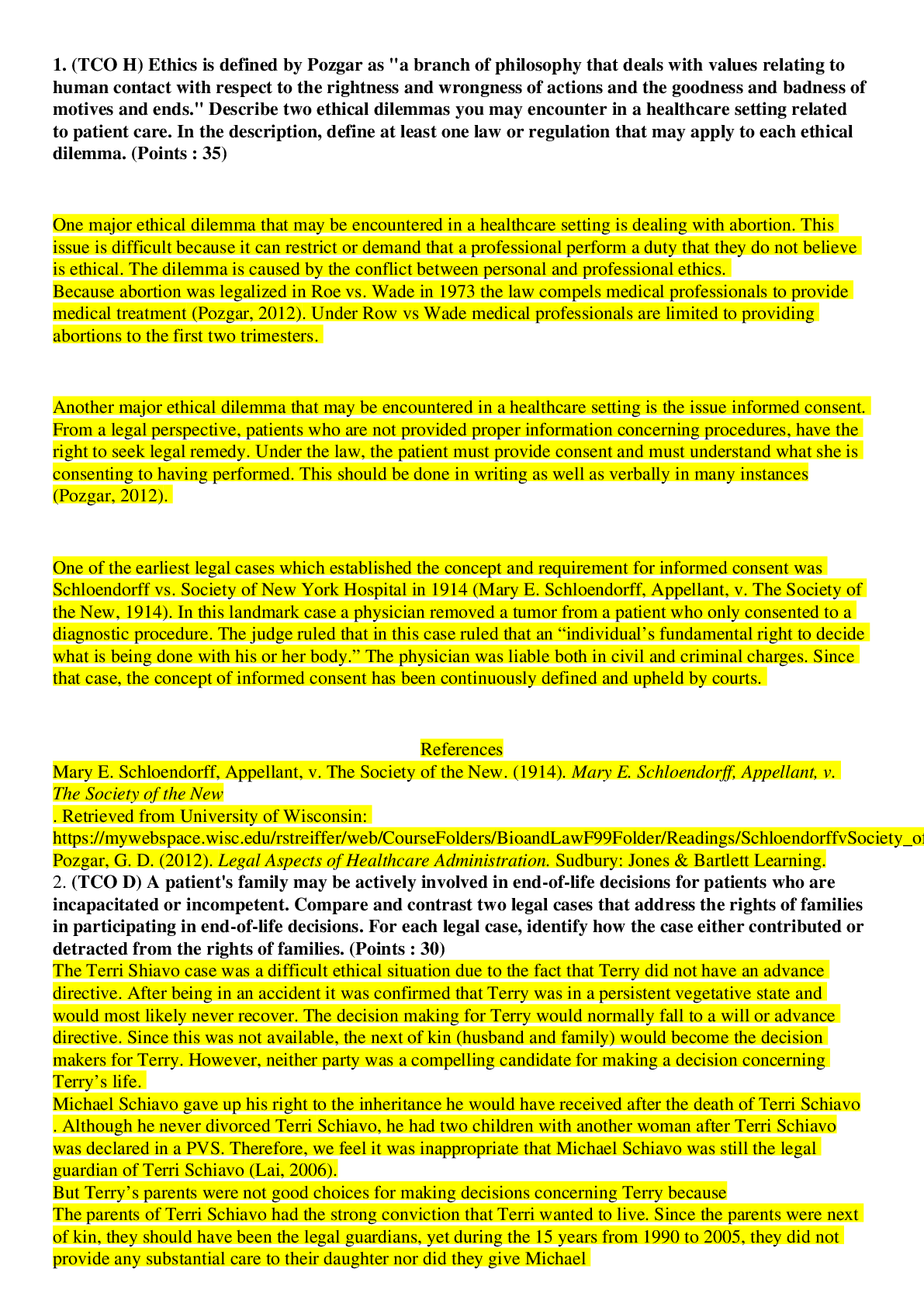University of Florida - NUR 3738SOC Exam 2. Already Graded A
Document Content and Description Below
SOC Exam 2, Child Health Material Exam Blueprint Total 50 questions Comfort: 1 *Infant care: 12 EVOLVE MATERNAL and EVOLVE NCLEX *Toddler/Preschooler: 10 EVOLVE MATERNAL and EVOLVE NCLEX Adolesc... ent: 1 *Respiratory: 6 EVOLVE MATERNAL and EVOLVE NCLEX *Neurological: 8 EVOLVE MATERNAL and EVOLVE NCLEX *Cardiovascular: 5 EVOLVE MATERNAL and EVOLVE NCLEX GI: 3 EVOLVE MATERNAL and EVOLVE NCLEX Calculations: 4 EVOLVE MATERNAL Select all that apply: 4 Maternal Child Nursing Care Chapters 24,28, 29, 30, 31, 32, 33, 34, 35, 39, 40, 41, 42, 48, 49 Saunders Review Chapters 21, 22, 37, 38, 39, 40, 42, 43, 44, 45 Saunders pages 257, 263-264, 543-545, 553 Developmental Milestones Track Social smile Push to prone Grasp rattle- A neat pincer grasp is characteristic of a 10-month-old infant. Hands midline Tripod sit Sit unassisted Pincer grasp Attempt to feed self Stack blocks Crawl Cruise (creep) Walk unassisted- By 12 to 13 months of age toddlers walk alone using a wide stance for extra balance Number of words age 1 year, 2 years, when should speech be 50% clear, 100% clear- Vocabulary increases dramatically, from 300 words at age 2 years to more than 2100 words at the end of 5 years At what age would the nurse advise parents to expect their infant to be able to say “mama” and “dada” with meaning? 10 months Run -18 months Throw ball overhead-18mon-3 years, toddler years. Ch.30 Assess pediatric pain using the age appropriate pain scale. 11. A 2-year-old child has been returned to the nursing unit after an inguinal hernia repair. Which pain assessment tool should the nurse use to assess this child for the presence of pain? a. FACES pain rating tool b. Numeric scale c. Oucher scale d. FLACC tool 1. 2. A behavioral pain tool should be used when the child is preverbal or does not have the language skills to express pain. The FLACC (face, legs, activity, cry, consolability) tool should be used with a 2-year-old child. The FACES, numeric, and Oucher scales are all self-report pain rating tools. Self-report measures are not sufficiently valid for children younger than 3 years of age because many children are not able to self-report their pain accurately. 1. An appropriate tool to assess pain in a 3-year-old child is the: (Select all that apply.) a. Visual Analog Scale (VAS) b. Adolescent and pediatric pain tool c. Oucher tool d. FACES pain-rating scale 3. ANS: C, D The Oucher tool can be used to assess pain in children 3 to 12 years of age. The FACES pain-rating scale can be used to assess pain for children 3 years of age and older. The VAS is indicated for use with older school-age children and adolescents. It can be used with younger school-age children, although less abstract tools are more appropriate. The adolescent and pediatric pain tool is indicated for use with children 8 to 17 years of age. 4. 5. 6. 7. 8. 9. 10. 11. 2. The nurse is using the FLACC scale to evaluate pain in a preverbal child. The nurse makes the following assessment: Face: occasional grimace; Leg: relaxed; Activity: squirming, tense; Cry: no cry; Consolability: content, relaxed. The nurse records the FLACC assessment as ________. (Record your answer as a whole number.) ANS: 2 12. Discuss non-pharmacologic pediatric comfort measures, and common pain medications, including their classes, used to manage pediatric pain or discomfort. 13. 14. 4. Which drug is usually the best choice for patient-controlled analgesia (PCA) for a child in the immediate postoperative period? a. Codeine b. Morphine c. Methadone d. Meperidine ANS: B 1. The most commonly prescribed medications for PCA are morphine, hydromorphone, and fentanyl. Parenteral use of codeine is not recommended. Methadone is not available in parenteral form in the United States. Meperidine is not used for continuous and extended pain relief. Chapter 24 1. Discuss benefits of breastfeeding for infants, mothers, families, society. 11. Which statement concerning the benefits or limitations of breastfeeding is inaccurate? a. Breast milk changes over time to meet changing needs as infants grow. b. Long-term studies have shown that the benefits of breast milk continue after the infant is weaned. c. Breast milk/breastfeeding may enhance cognitive development. d. Breastfeeding increases the risk of childhood obesity. 2. ANS: D Breastfeeding actually decreases the risk of childhood obesity. There are multiple benefits of breastfeeding. Breast milk changes over time to meet changing needs as infants grow. Long-term studies have shown that the benefits of breast milk continue after the infant is weaned. Breast milk/breastfeeding may enhance cognitive development. 3. A pregnant woman wants to breastfeed her infant; however, her husband is not convinced that there are any scientific reasons to do so. The nurse can give the couple printed information comparing breastfeeding and bottle-feeding. Which statement is most accurate? Bottle-feeding using commercially prepared infant formulas: a. increases the risk that the infant will develop allergies. b. helps the infant sleep through the night. c. ensures that the infant is getting iron in a form that is easily absorbed. d. requires that multivitamin supplements be given to the infant. Exposure to cow’s milk poses a risk of developing allergies, eczema, and asthma. “Bottle-feeding using commercially prepared infant formulas helps the infant sleep through the night” is a false statement. Iron is better absorbed from breast milk than from formula. Commercial formulas are designed to meet the nutritional needs of the infant and resemble breast milk. 3. Recognize infant feeding readiness and hunger cues, and indicators of effective feeding. 4. A after birth woman telephones about her 4-day-old infant. She is not scheduled for a weight check until the infant is 10 days old, and she is worried about whether breastfeeding is going well. Effective breastfeeding is indicated by the newborn who: a. sleeps for 6 hours at a time between feedings. b. has at least one breast milk stool every 24 hours. c. gains 1 to 2 ounces per week. d. has at least 6 to 8 wet diapers per day. 4. ANS: D After day 4, when the mother’s milk comes in, the infant should have 6 to 8 wet diapers every 24 hours. Sleeping for 6 hours between feedings is not an indication of whether the infant is breastfeeding well. Typically infants sleep 2 to 4 hours between feedings, depending on whether they are being fed on a 2- to 3-hour schedule or cluster fed. The infant should have a minimum of three bowel movements in a 24-hour period. 5. Breastfed infants typically gain 15 to 30 g/day. 7. At a 2-month well-baby examination, it was discovered that a breastfed infant had only gained 10 ounces in the past 4 weeks. The mother and the nurse agree that, to gain weight faster, the infant needs to: a. begin solid foods. b. have a bottle of formula after every feeding. c. add at least one extra breastfeeding session every 24 hours. d. start iron supplements. ANS: C Usually the solution to slow weight gain is to improve the feeding technique. Position and latch-on are evaluated, and adjustments are made. It may help to add a feeding or two in a 24-hour period. Solid foods should not be introduced to an infant for at least 4 to 6 months. Bottle-feeding may cause nipple confusion and limit the supply of milk. Iron supplements have no bearing on weight gain. 6. Compare and contrast infant formulas and breastmilk as they relate to nutritional content, timings of feedings, stooling patterns, safe warming, and storage. 2. A new father is ready to take his wife and newborn son home. He proudly tells the nurse who is discharging them that within the next week he plans to start feeding the infant cereal between breastfeeding sessions. The nurse can explain to him that beginning solid foods before 4 to 6 months may: a. decrease the infant’s intake of sufficient calories. b. lead to early cessation of breastfeeding. c. help the infant sleep through the night. d. limit the infant’s growth. 1. ANS: B Introduction of solid foods before the infant is 4 to 6 months of age may result in overfeeding and decreased intake of breast milk. It is not true that feeding of solids helps infants sleep through the night. The proper balance of carbohydrate, protein, and fat for an infant to grow properly is in the breast milk or formula. 14. The best reason for recommending formula over breastfeeding is that: a. the mother has a medical condition or is taking drugs that could be passed along to the infant via breast milk. b. the mother lacks confidence in her ability to breastfeed. c. other family members or care providers also need to feed the baby. d. the mother sees bottle-feeding as more convenient. ANS: A Breastfeeding is contraindicated when mothers have certain viruses, are undergoing chemotherapy, or are using/abusing illicit drugs. A lack of confidence, the need for others to feed the baby, and the convenience of bottle-feeding are all honest reasons for not breastfeeding, although further education concerning the ease of breastfeeding and its convenience, benefits, and adaptability (expressing milk into bottles) could change some minds. In any case the nurse must provide information in a nonjudgmental manner and respect the mother’s decision. Nonetheless, breastfeeding is definitely contraindicated when the mother has medical or drug issues of her own. 2. Calculate appropriate and expected I/O for infants and toddlers. Pediatric Fluid And Output Calculation A. BODY WEIGHT METHOD (Remember to convert lbs. to kgs.) (p. 1095) 1. Daily maintenance fluid requirement formula: 0-10 kg 100 mL/kg/day (100 x kg) 11-20 kg 1000 mL (for first 10 kg) + 50 mL/kg/day for each additional kg between 10- 20 kg over 20 kg 1500 mL (for first 20 kg) + 20 mL/kg/day for each additional kg over 20 kg 2. Hourly maintenance fluid requirements: Divide daily volume by 24 (hours/day) Examples: • Calculate the daily and hourly maintenance fluid requirements for a child weighing 5 kg. 100 mL x 5 kg = 500 mL / day 500 mL 24 hours = 20.8 mL / hr • Calculate the daily and hourly maintenance fluid requirements for a child weighing 15 kg. 10 x 100ml/kg=1000 mL + (5 kgx50 mL)=250 = 1000 + 250 = 1250 mL/day 1250 mL 24 = 52 mL / hr • Calculate the daily and hourly maintenance fluid requirements for a child weighing 22 kg 10 x 100ml/kg = 1000ml PLUS 10 x 50ml/kg = 500ml PLUS =1500 mL + (20 mL X 2 kg) = 40, (1500 + 40) = 1540 mL/day 1540 mL 24 = 64 mL / hr C. OUTPUT CALCULATION 1. Convert grams to mL (1 gram = 1 mL) 2. Normal output: 1-3 cc/kg/hr, 3. Divide total output volume by weight and hours Example: • Calculate the cc/kg/hr for a 5-kg infant who had the following output over the past 8 hours: 33g, 27g and 30 g diapers. Scale zeroed with dry diaper. 33 + 27 + 30 = 90 mL total 90 mL 8 hours = 11.25 mL/hr 11.25 5 kg = 2.25 mL/kg/hr Output is within normal range The normal range for 24-hour urine volume is 800 to 2000 milliliters per day (with a normal fluid intake of about 2 liters(2,000 ml) per day). Oliguria is urine output < 500 mL in 24 h (0.5 mL/kg/h) in an adult. Oliguria is urine output < 1 L in 24 h (1 mL/kg/h) in a child. Estimating Fluid Needs • 0-10kg = 100ml/kg • 11-20kg = 50ml/kg • >20kg = 20ml/kg • 8kg 8 x 100ml/kg = 800ml/day • 14kg 10 x 100ml/kg = 1000ml PLUS 4 x 50ml/kg = 200ml = 1200ml per day • 21kg 10 x 100ml/kg = 1000ml PLUS 10 x 50ml/kg = 500ml PLUS 1 x 20ml/kg = 20ml = 1520ml per day 3. Identify oral candidiasis and how it can impact infant feeding. 4. Prioritize appropriate nursing diagnoses related to infant feeding. Chapter 28, 29 1. Predict the anticipated normal physical growth and development, cognitive, language/communication, and social milestones during infancy. The nurse educator is preparing to conduct a teaching session for the nursing staff regarding the theories of growth and development and plans to discuss Kohlberg's theory of moral development. What information should the nurse include in the session? Select all that apply. 1.Moral development progresses in relationship to cognitive development. 2.A person's ability to make moral judgments develops over a period of time. 3.The theory provides a framework for understanding how individuals determine a moral code to guide their behavior. 4. In stage 2 (instrumental-relativist orientation), the child conforms to rules to obtain rewards or have favors returned. Which interventions are appropriate for the care of an infant? Select all that apply. Provide swaddling. Hang mobiles with black and white contrast designs. Caress the infant while bathing or during diaper changes. The nurse at a well-baby clinic is assessing the language and communication developmental milestones of a 4-month-old infant/6 month in power-point. On the basis of the age of the infant, what should the nurse expect to note as the highest-level developmental milestone? Babbling sounds 2. Discuss interventions and education for parents of infants with slow growth. 3. Describe the role of play in the growth and development of children The pediatric nurse is caring for a hospitalized toddler. What does the nurse determine is the most appropriate play activity for the toddler? Playing with a push-pull toy A 7-year-old child is hospitalized with a fracture of the femur and is placed in traction. In meeting the psychosocial needs of the child, the nurse most appropriately selects which play activity for the child? A board game 4. Prioritize the appropriate nursing diagnoses in infants related to growth and development. The nurse at a well-baby clinic is assessing the motor development of a 24-month-old child. On the basis of the age of the child, the nurse expects to note what as the highest-level developmental milestone? The child opens a door by turning the doorknob. A 2-year-old child has been admitted to the hospital for management of pneumonia. The child is placed in an oxygen tent. Taking into consideration the child's age and developmental level and the treatment being administered, which statement is appropriate for the nurse to make to the parents? "You can sit next to him and hold his hand through the tent, but he needs to remain inside of it." 5. Document growth on a pediatric growth chart. A 6-month-old infant is admitted to the hospital. The nurse weighs the infant and notes that the infant's weight is 14 pounds. Which statement by the mother indicates that further teaching is needed? "I will have to increase his milk intake because he is not gaining enough weight." Which would be the highest expected growth and development occurrences at 9 months/12 mos in powerpoint of age for an infant who has had appropriate growth assessed at each well-child visit? Select all that apply. Should be able to say "mama" and "dada" Will pull up and stand for several seconds holding on to furniture Will be able to pick up small pieces of food when placed in a high chair Which would be the highest expected growth and development occurrence at 12 months of age for an infant who has had appropriate growth assessed at each well-child visit? Walks holding on to someone's hand The nurse is developing a plan of care for a 4-year-old child scheduled for a renal biopsy. What developmental characteristic of this child should the nurse consider? Fears of mutilation may be present in the child. 6. Identify evidence of adequate, deficient or excess nutrition in infants. The nurse at a well-baby clinic is providing nutrition instructions to the mother of a 1-month-old infant. What instruction should the nurse give to the mother? Breast milk or formula is the main food. Chapter 31 1. Identify the recommended first immunization given to infants. A child who is 4 years old is seen for a well-child checkup. He has been regularly receiving immunizations. Which immunizations should the child receive at this visit? Select all that apply. Varicella vaccine Inactivated polio vaccine Measles, mumps, rubella (MMR) vaccine 2. Discuss the relationship between parent-child attachment, separation anxiety and stranger fear to developmental milestones during infancy 3. List general contraindications, precautions, and administration routes for immunizations An infant receives a diphtheria, tetanus, and acellular pertussis (DTaP) immunization at a well-baby clinic. The parent returns home and calls the clinic to report that the infant has developed swelling and redness at the site of injection. Which intervention should the nurse suggest to the parent? Apply a cold pack to the injection site. A child is receiving a series of the hepatitis B vaccine and arrives at the clinic with his parent for the second dose. Before administering the vaccine, the nurse should ask the child and parent about a history of a severe allergy to which substance? A previous dose of hepatitis B vaccine or component The clinic nurse is assessing a child who is scheduled to receive a live virus vaccine (immunization). What are the general contraindications associated with receiving a live virus vaccine? Select all that apply. The child had a previous anaphylactic reaction to the vaccine. The child has a disorder that caused a severely deficient immune system. The clinic nurse prepares to administer a measles, mumps, and rubella (MMR) vaccine to a 5-year-old child. The nurse should administer this vaccine by which method? Subcutaneously in the outer aspect of the upper arm A child with rubeola (measles) is being admitted to the hospital. In preparing for the admission of the child, the nurse should plan to place the child on which precautions? Airborne A child was seen in the health care clinic and received an immunization of DPT (diphtheria, pertussis, tetanus) vaccine. One hour later, the mother calls the clinic and tells the nurse that the injection site is painful and red. Which instruction should the nurse provide to the mother? Apply cold compresses for 24 hours for 20 minutes at a time. The nurse is preparing to administer an MMR (measles, mumps, and rubella) vaccine to a 15-month-old child. Before administering the vaccine, which question should the nurse ask the mother of the child? "Is the child allergic to any antibiotics?" Several children have contracted rubeola (measles) in a local school, and the school nurse conducts a teaching session for the parents of the schoolchildren. Which statement made by a parent indicates a need for further teachingregarding this communicable disease? "The disease can be spread to others from 10 days before any sign of the disease appears to 15 days after the rash appears." The nurse provides instructions to the mother of a child with mumps regarding respiratory precautions, and the mother asks the nurse about the length of time required for the respiratory precautions. The nurse should make which statement to the mother? "Precautions are indicated during the period of communicability." An infant is brought to the clinic for his third diphtheria–tetanus toxoid–acellular pertussis vaccination (DTaP). The mother reports that the infant developed a 99.4°F (37.4°C) temperature after the last DTaP. Which action is most appropriate? Administer the vaccination. A child is scheduled to receive immunizations. The child's mother reports to the nurse that the child has been receiving long-term immunosuppressive therapy. The nurse prepares the scheduled immunizations knowing that which vaccine is contraindicated? MMR (measles-mumps-rubella) 4. Discuss the anticipatory guidance to parents regarding safety and injury prevention based on the infant’s developmental stage. The nurse is assigned to care for a hospitalized toddler. The nurse plans care, knowing that what should be the highest priority? Protecting the toddler from injury 5. Discuss the nursing assessment, interventions, and appropriate nursing diagnoses in caring for infants with failure to thrive. Which strategy might be recommended for an infant with failure-to-thrive to increase caloric intake? Being persistent through 10 to 15 minutes of food refusal The primary goals in the nutritional management of children with failure to thrive (FTT) are: allow for catch-up growth, correct nutritional deficiencies, achieve ideal weight for height, restore optimum body composition. 6. Provide anticipatory guidance for the prevention of sudden infant death syndrome (SIDS), and families with infants with colic. A new parent expresses concern to the nurse regarding sudden infant death syndrome (SIDS). She asks the nurse how to position her new infant for sleep. In which position should the nurse tell the parent to place the infant? Back rather than on the stomach A nursing student is conducting a clinical conference about measures that assist in preventing sudden infant death syndrome. The student plans to write on a handout that it is best to place an infant in which position for sleep? On the back, or supine 7. Discuss the five most common evidence-supported comfort measures for infants and ways in which infants self-soothe. 8. Prioritize common nursing diagnoses related to safety and injury prevention in infants, the colicky infant as well as nursing diagnoses related to the families during developmental stages. Parents bring their child to the emergency department and tell the nurse that the child has been complaining of colicky abdominal pain located in the lower right quadrant of the abdomen. The nurse suspects that the child has which disorder? Appendicitis Chapter 48 1. Identify the common assessments to identify, and treatment modalities in, developmental dysplasia of the hip. The nurse is assisting a health care provider (HCP) examining a 3-week-old infant with developmental dysplasia of the hip. What test or sign should the nurse expect the HCP to assess? Ortolani's maneuver A child with developmental dysplasia of the hip is placed in a Pavlik harness. The nurse should demonstrate to the parents how to place the child in this harness by placing the child's legs in which position? Abduction The nurse is assisting a health care provider (HCP) during the examination of an infant witih developmental hip dysplasia. The HCP performs the Ortolani maneuver. The nurse determines that the infant exhibits a positive response to this maneuver if which finding is noted? A palpable click during abduction of the affected hip The nurse provides instructions to the parents of an infant with hip dysplasia regarding care of the Pavlik harness. Which statement by one of the parents indicates an understanding of the use of the harness? "I can remove the harness to bathe my infant." 2. Discuss the treatment plan, goals, and anticipatory guidance in the treatment of treatment for clubfoot. Parents bring their 2-week-old infant to a clinic for treatment after a diagnosis of clubfoot made at birth. Which statement by the parents indicates a need for further teaching regarding this disorder? "I need to bring my infant back to the clinic in 1 month for a new cast." 3. Prioritize the nursing diagnoses related to DDH and clubfoot. The nurse is implementing a teaching plan for a 4-month-old child who has been diagnosed with developmental dysplasia of the hip. The child will be placed in the Pavlik harness. Which statement by the family indicates that they understand the care of their child while placed in the Pavlik harness? "I will watch for any redness or skin irritation where the straps are applied and call the health care provider for red areas." 1. Using the Denver Developmental Screening as your guide, predict the anticipated physical growth and development, motor skills, cognitive, language/communication, and social milestones achieved during toddlerhood and preschool years. During a well-child visit, the father of a 4-year-old boy tells the nurse that he is not sure if his son is ready for kindergarten. His birthday is close to the cutoff date, and he has not attended preschool. The nurse’s BEST recommendation is to: perform developmental screening. The mother of a 5-year-old child tells the nurse that the child scolds the floor or a table if she hurts herself on the object. The nurse educates the mother according to Piaget's theory of cognitive development and its terminology and definitions. Which statement by the mother indicates that the teaching has been effective? "This is an example of animism." 2. Discuss the anticipatory guidance needed for physiological anorexia seen in toddlers. 3. Discuss common triggers and anticipatory guidance for toddler temper tantrums, common sleep issues, regression, and negativism. A parent of a 3-year-old tells a clinic nurse that the child is rebelling constantly and having temper tantrums. Using Erikson's psychosocial development theory, which instructions should the nurse provide to the parent? Select all that apply. Set limits on the child's behavior. Provide a simple explanation of why the behavior is unacceptable The mother of a toddler informs the nurse that her child has frequent temper tantrums. The nurse should instruct the mother to implement which measure to deal with the temper tantrums? Ignore the behavior 4. Describe the role of play and imaginary playmates in the growth and development of toddlers and children. The parents of a 4-year-old/preschool in powerpoints girl are worried because she has an imaginary playmate. The nurse’s BEST response is to tell the parents: having imaginary playmates is normal and useful at this age. 5. Calculate appropriate I/O for infants and toddlers. 6. Identify the developmental approach for the physical examination of the toddler and young child. The nurse is preparing to perform a pediatric physical examination. The child refuses to sit on the examining table, screams when the nurse attempts to perform the assessment, and does not make eye contact. What is the most appropriate initial nursing action? Talk to the parent while ignoring the child. 7. Identify evidence of adequate, deficient or excess nutrition in toddlers. 8. Discuss the developmental signs of toddler readiness for toilet training A nursing student is presenting a clinical conference to peers regarding Freud's psychosexual stages of development, specifically the anal stage. The student explains to the group that which characteristic relates to this stage of development? This stage is associated with toilet training. 9. Discuss anticipatory guidance related to lying, cheating, stealing in the preschool years. 10. Discuss safety promotion and injury prevention based on the developmental level of toddlers and preschoolers. 11. Discuss the proper use and age recommendations of car restraints in pediatrics Which car safety device should be used for a child who is 8 years old and 4 feet tall? Booster seat 12. Relate magical thinking in toddlers and preschoolers to their developmental stages. The nurse educator is orienting a new nurse to the pediatric unit and is including tips for medication administration. Which statement by the new nurse indicates that the teaching has been effective? "It helps to use magical thinking with the preschool age group." The nurse is caring for a 4-year-old child/preschool ppt. . When experiencing pain, the nurse anticipates which about the child? Select all that apply. Views pain as a punishment Blames someone else for the pain Believes pain will disappear magically 13. Discuss anticipatory guidance for families regarding speech development and stuttering during the preschool years. The nurse is assessing a preschool age child who is stuttering when answering the nurse’s questions. The nurse should offer alternate methods of responding to the stuttering when observing the parent: completing the child’s sentences. Accidental Poisonings, Ingestions 1. Identify common items ingested by children that cause injury. 2. Explain the rationale for "the arsenic hour". 3. Discuss developmentally appropriate anticipatory guidance for the prevention of accidental ingestions in children. 4. Identify children at high risk for lead poisoning. 5. Identify Tanner Stages in males and females. 6. Discuss the most common causes of injury during adolescence and strategies for prevention of injury. 7. Identify the recommended age range for administration of the human papilloma vaccine (HPV). 8. Identify the major health and psychosocial concerns of the adolescent years (ex. peer groups, interpersonal relationships, sexuality, etc.). 9. Discuss the concept of the "adolescent brain" in terms of how it differs from "adult brain". 10. Identify nursing diagnosis for the hospitalized, or chronically ill adolescent. 11. Discuss guidelines for therapeutic communication with adolescents. 12. Discuss the typical developmental milestones, fears, during the adolescent period. 13. Describe the physical exam, therapies, treatment modalities, and nursing diagnoses for a child with scoliosis. A child who has undergone spinal fusion for scoliosis complains of abdominal discomfort and begins to have episodes of vomiting. On further assessment, the nurse notes abdominal distention. On the basis of these findings, the nurse should take which action? Notify the health care provider (HCP). The nurse is providing instructions to the parents of a child with scoliosis regarding the use of a brace. Which statement by the parents indicates a need for further instruction? "I should apply lotion under the brace to prevent skin breakdown." A child must wear a brace for correction of scoliosis. The nurse creates a plan of care knowing the child is at risk for which problem? Breaks in skin integrity A nursing student is assisting a school nurse in performing scoliosis screening on the children in the school. The nurse assesses the student's preparation for conducting the screening. The nurse determines that the student demonstrates understanding of the disorder when the student states that scoliosis is characterized by which finding? Abnormal lateral curvature of the spine Respiratory Distress 1. Discuss the signs and symptoms of respiratory distress in the pediatric population. 30. Why do infants and young children quickly have respiratory distress in acute and chronic alterations of the respiratory system? a. They have a widened, shorter airway. b. There is a defect in their sucking ability. c. The gag reflex increases mucus production. d. Mucus and edema obstruct small airways. ANS: D The airway in infants and young children is narrower, not wider, and respiratory distress can occur quickly because mucus and edema can cause obstruction to their small airways. Sucking is not necessarily related to problems with the airway. The gag reflex is necessary to prevent aspiration. It does not produce mucus. 30. Why do infants and young children quickly have respiratory distress in acute and chronic alterations of the respiratory system? a. They have a widened, shorter airway. b. There is a defect in their sucking ability. c. The gag reflex increases mucus production. d. Mucus and edema obstruct small airways. ANS: D The airway in infants and young children is narrower, not wider, and respiratory distress can occur quickly because mucus and edema can cause obstruction to their small airways. Sucking is not necessarily related to problems with the airway. The gag reflex is necessary to prevent aspiration. It does not produce mucus. 2. Compare and contrast the respiratory system of the child with that of the adult. 3. Discuss the nurse's role in the support and treatment in a child with respiratory distress. A humidified atmosphere is recommended for a young child with an upper respiratory tract infection because this environment facilitates: soothing inflamed mucous membrane. 4. Identify impending respiratory failure in the pediatric population. Bronchiolitis, RSV 1. Discuss treatment guidelines, infection control, anticipatory guidance in bronchiolitis, RSV. The nurse is caring for a 10-month-old infant diagnosed with respiratory syncytial virus (RSV) bronchiolitis. Which interventions should be included in the child’s care? (Select all that apply.) a. Administer antibiotics b. Administer cough syrup c. Encourage infant to drink 8 ounces of formula every 4 hours d. Institute cluster care to encourage adequate rest e. Place on noninvasive oxygen monitoring ANS: C, D, E Hydration is important in children with RSV bronchiolitis to loosen secretions and prevent shock. Clustering of care promotes periods of rest. The use of noninvasive oxygen monitoring is recommended. 28. Which information should the nurse stress to workers at a day care center about respiratory syncytial virus (RSV)? a. RSV is transmitted through particles in the air. b. RSV can live on skin or paper for up to a few seconds after contact. c. RSV can survive on nonporous surfaces for about 60 minutes. d. Frequent hand washing can decrease the spread of the virus. ANS: D Meticulous hand washing can decrease the spread of organisms. RSV infection is not airborne. It is acquired mainly through contact with contaminated surfaces. RSV can live on skin or paper for up to 1 hour and on cribs and other nonporous surfaces for up to 6 The nurse is caring for an infant with bronchiolitis, and diagnostic tests have confirmed respiratory syncytial virus (RSV). On the basis of this finding, which is the most appropriate nursing action? Move the infant to a room with another child with RSV. The nurse is caring for a hospitalized infant with a diagnosis of bronchiolitis. In which position should the nurse place the infant? Head and chest at a 30-degree angle with the neck slightly extended 2. Identify patients who meet the guidelines for Synagis administration. An infant with a congenital heart defect is receiving palivizumab (Synagis). The purpose of this is to: prevent respiratory syncytial virus (RSV) infection Croup, Epiglottitis, Pertussis 1. Differentiate between the diagnoses of croup, epiglottitis, and pertussis in presentation, evidence based treatment. 27. Which intervention for treating croup at home should be taught to parents? a. Have a decongestant available to give the child when an attack occurs. b. Have the child sleep in a dry room. c. Take the child outside if air is cool and moist. d. Give the child an antibiotic at bedtime. ANS: C Taking the child into the cool, humid, night air may relieve mucosal swelling and improve symptoms. Decongestants are inappropriate for croup, which affects the middle airway level. A dry environment may contribute to symptoms. Croup is caused by a virus. Antibiotic treatment is not indicated. 26. What distinguishing manifestation of spasmodic croup should parents be taught to identify? a. Wheezing is heard audibly b. It has a harsh, barky cough c. It is bacterial in nature d. The child has a high fever ANS: B Spasmodic croup is viral in origin, is usually preceded by several days of symptoms of upper respiratory tract infection, and often begins at night. It is marked by a harsh, metallic, barky cough; sore throat; inspiratory stridor; and hoarseness. Wheezing is not a distinguishing manifestation of croup. It can accompany conditions such as asthma or bronchiolitis. A high fever is not usually present. 9. Which type of croup is always considered a medical emergency? a. Laryngitis b. Epiglottitis c. Spasmodic croup d. Laryngotracheobronchitis (LTB) ANS: B Epiglottitis is always a medical emergency needing antibiotics and airway support for treatment. Laryngitis is a common viral illness in older children and adolescents with hoarseness and upper respiratory infection symptoms. Spasmodic croup is treated with humidity. LTB may progress to a medical emergency in some children A child with laryngotracheobronchitis (croup) is placed in a cool mist tent. The mother becomes concerned because the child is frightened, consistently crying and trying to climb out of the tent. Which is the most appropriate nursing action? Let the mother hold the child and direct the cool mist over the child's face. The mother of a hospitalized 2-year-old child with viral laryngotracheobronchitis (croup) asks the nurse why the health care provider did not prescribe antibiotics. Which response should the nurse make? "Antibiotics are not indicated unless a bacterial infection is present." The nurse is providing instructions to the mother of a child with croup regarding treatment measures if an acute spasmodic episode occurs. Which statement made by the mother indicates a need for further teaching? "I should place a steam vaporizer in my child's room." 2. Describe the nursing care and anticipatory guidance for the diagnoses of croup, epiglottitis, pertussis. 34. The nurse is assessing a child with acute epiglottitis. Examining the child’s throat by using a tongue depressor might precipitate which symptom or condition? a. Inspiratory stridor b. Complete obstruction c. Sore throat d. Respiratory tract infection ANS: B If a child has acute epiglottitis, examination of the throat may cause complete obstruction and should be performed only when immediate intubation can take place. Stridor is aggravated when a child with epiglottitis is supine. Sore throat and pain on swallowing are early signs of epiglottitis. Epiglottitis is caused by Haemophilus influenzae in the respiratory tract. The emergency department nurse is caring for a child diagnosed with epiglottitis. In assessing the child, the nurse should monitor for which indication that the child may be experiencing airway obstruction? The child is leaning forward, with the chin thrust out. The nurse provides home care instructions to the parents of a child hospitalized with pertussis who is in the convalescent stage and is being prepared for discharge. Which statement by a parent indicates a need for further instruction? "We need to maintain droplet precautions and a quiet environment for at least 2 weeks." A mother arrives at the hospital emergency department with her child, in whom a diagnosis of epiglottitis is documented. Which prescription, if written by the health care provider, should the nurse question? Obtain a throat culture. The nurse employed in an emergency department is monitoring a child diagnosed with epiglottitis. The nurse notes that the child is leaning forward with the chin thrust out. How should the nurse interpret this finding? An airway obstruction A child hospitalized with pertussis is in the convalescent stage, and the nurse is preparing the child for discharge. The nurse has provided instructions to the parents for home care of the child. Which statement by a parent indicates a need for further teaching? "I need to make sure that the child is isolated from the other children for at least 2 weeks to prevent the spread of the virus to them." The mother of a 20-month-old boy tells the nurse that he has a barking cough at night. His temperature is 37° C. The nurse suspects croup and should recommend: trying a cool-mist vaporizer at night and watching for signs of difficulty breathing. A 5-year-old child is brought to the Emergency Department with abrupt onset of sore throat, pain with swallowing, fever, and sitting upright and forward. Acute epiglottitis is suspected. What are the most appropriate nursing interventions? Vital signs, Medical history, Assessment of breath sound 3. Describe various modalities for assessing cerebral function in children. The nursing student is writing a plan of care for a child who presents with an acute head injury. The nursing instructor reviews the plan of care and praises the student for identifying which assessment as a priority? Airway and breathing The nurse is reviewing a chart for a child with a head injury. The nurse notes that the level of consciousness has been documented as obtunded. Which finding should the nurse expect to note on assessment of the child? Not easily arousable and limited interaction The nurse is performing an assessment on a child with a head injury. The nurse notes an abnormal flexion of the upper extremities and an extension of the lower extremities. What should the nurse document that the child is experiencing? Decorticate posturing The nurse is caring for a child with a head injury. The nurse observes decerebrate posturing. What is the nurse's best action? Notify the health care provider. The nurse is caring for a child who sustained a head injury after falling from a tree. On assessment of the child, the nurse notes the presence of a watery discharge from the child's nose. The nurse should immediately test the discharge for the presence of which substance? Glucose The nurse is caring for an infant with spina bifida (myelomeningocele type) who had the sac on the back containing cerebrospinal fluid, the meninges, and the nerves (gibbus) surgically removed. The nursing plan of care for the postoperative period should include which action to maintain the infant's safety? Elevating the head with the infant in the prone position The nurse is monitoring a child with a brain tumor for complications associated with increased intracranial pressure. Which finding, if noted by the nurse, would indicate the presence of diabetes insipidus? High urine output The nurse is assigned to care for a child with a brain injury who has a temporal lobe herniation and increasing intracranial pressure. Which signs should the nurse identify as indicative of this type of injury? Select all that apply. Flaccid paralysis Ipsilateral pupil dilation Shifting of the temporal lobe laterally across the tentorial notch The nurse is assessing a child with increased intracranial pressure. On assessment, the nurse notes that the child is now exhibiting decerebrate posturing. The nurse should modify the client's plan of care based on which interpretation of the client's change? Deteriorating neurological function The nurse is reviewing the record of a child with increased intracranial pressure and notes that the child has exhibited signs of decerebrate posturing. Which assessment finding should the nurse expect if this type of posturing is present? Abnormal extension of the upper and lower extremities with some internal rotation. 4. Describe the preoperative and postoperative care and monitoring of a child with hydrocephalus. An infant with a diagnosis of hydrocephalus is scheduled for surgery. Which is the priority nursing intervention in the preoperative period? Reposition the infant frequently. The nurse notes that an infant with the diagnosis of hydrocephalus has a head that is heavier than that of the average infant. The nurse should determine that special safety precautions are needed when moving the infant with hydrocephalus. Which statement should the nurse plan to include in the discharge teaching with the parents to reflect this safety need? "When picking up your infant, support the infant's neck and head with the open palm of your hand." 5. Outline a nursing plan of care for the child with meningitis, including prevention, infection control, and monitoring. A lumbar puncture is performed on a child suspected to have bacterial meningitis, and cerebrospinal fluid (CSF) is obtained for analysis. The nurse reviews the results of the CSF analysis and determines that which results would verify the diagnosis? Cloudy CSF, elevated protein, and decreased glucose levels The nurse is planning care for a child with acute bacterial meningitis. Based on the mode of transmission of this infection, which precautionary intervention should be included in the plan of care? Maintain respiratory isolation precautions for at least 24 hours after the initiation of antibiotics. The community health nurse is providing information to parents of children in a local school regarding the signs of meningitis. The nurse informs the parents that the classic signs/symptoms of meningitis include which findings? Severe headache, fever, and a change in the level of consciousness The nurse is assessing for Kernig's sign in a child with a suspected diagnosis of meningitis. Which action should the nurse perform for this test? Raise the child's leg with the knee flexed and then extend the leg at the knee and assess for pain. A child is admitted to the hospital with a diagnosis of acute bacterial meningitis. In reviewing the health care provider's prescriptions, which would the nurse question as appropriate for a child with this diagnosis? Administer an oral antibiotic. 6. Identify signs of increased intracranial pressure in infants and children. A mother arrives at the emergency department with her 5-year-old/preschool child and states that the child fell off a bunk bed. A head injury is suspected. The nurse checks the child's airway status and assesses the child for early and late signs of increased intracranial pressure (ICP). Which is a late sign of increased ICP? Bradycardia 7. Discuss the nursing care and medical treatment for patients with increased intracranial pressure. The nurse is monitoring a 3-year-old child/preschool for signs and symptoms of increased intracranial pressure (ICP) after a craniotomy. The nurse plans to monitor for which early sign or symptom of increased ICP? Vomiting/ bulging fontanelle in powerpoint The nurse is reviewing the record of a child with increased intracranial pressure and notes that the child has exhibited signs of decerebrate posturing. On assessment of the child, the nurse expects to note which characteristic of this type of posturing? Rigid extension and pronation of the arms and legs 8. Discuss the treatment and long term sequelae of children with a neural tube defect. 9. Differentiate between the different classes of cerebral palsy. Cerebral palsy (CP) is suspected in a child and the parents ask the nurse about the potential warning signs of CP. The nurse should provide which information? Select all that apply. T The infant's arms or legs are stiff or rigid A high risk factor for CP is very low birth weight. The infant has feeding difficulties, such as poor sucking and swallowing. If the infant is able to crawl, only one side is used to propel himself or herself. 10. Formulate the anticipatory guidance for families of children with cerebral palsy. A child with cerebral palsy is in a management program to achieve maximum potential for locomotion, self-care, and socialization in school. The nurse works with the child to meet these goals by performing which action? Placing the child on a wheeled scooter board 11. Identify developmental signs that can be seen in the diagnosis of cerebral palsy. 1. Differentiate a cardiac defect with a right-to-left shunt and a cardiac defect of a left-to-right shunt (i.e. cyanotic and acyanotic defects) based on history and physical exam. Congenital heart defects have traditionally been divided into acyanotic or cyanotic defects. The nurse should recognize that in clinical practice this system is: problematic because children with acyanotic heart defects may develop cyanosis. 2. Prioritize the nursing care and interventions of a child with a suspected or known congenital cardiac defect. Which is considered a mixed cardiac defect? Transposition of the great arteries 3. Using findings on physical exam, differentiate between an atrial septal defect (ASD), ventricular septal defect (VSD), Tetralogy of Fallot, patent ductus arteriosis (PDA), pulmonic stenosis, and transposition of the great vessels. The doctor suggests that surgery be performed for patent ductus arteriosus (PDA) to prevent: increased pulmonary vascular congestion. Assessment findings of an infant admitted to the hospital reveal a machinery-like murmur on auscultation of the heart and signs of heart failure. The nurse reviews congenital cardiac anomalies and identifies the infant's condition as which disorder? Refer to the figure (circled area) to determine the condition. Patent ductus arteriosus The nurse is caring for an infant with a diagnosis of tetralogy of Fallot. The infant suddenly becomes cyanotic, and the nurse recognizes that the infant is experiencing a hypercyanotic spell (blue or tet spell). The nurse immediately places the infant in what position? Knee-chest position A child with a diagnosis of tetralogy of Fallot exhibits an increased depth and rate of respirations. On further assessment, the nurse notes increased hypoxemia. The nurse interprets these findings as indicating which situation? A hypercyanotic episode The nurse is assigned to care for an infant with tetralogy of Fallot. The mother of the infant calls the nurse to the room because the infant suddenly seems to be having difficulty breathing. The nurse enters the room and notes that the infant is experiencing a hypercyanotic episode. What is the priority action by the nurse? Place the infant in a knee-chest position. A young child with tetralogy of Fallot may assume a posturing position as a compensatory mechanism. The position automatically assumed by the child is: squatting. 4. Identify common sequelae and their treatments and prevention found in children with congenital cardiac defects. The nurse is monitoring an infant with heart failure. Which sign alerts the nurse to suspect fluid accumulation and the need to call the health care provider? A weight gain of 1 lb (0.5 kg) in 1 day The nurse is caring for a child with a diagnosis of a right-to-left cardiac shunt. On review of the child's record, the nurse should expect to note documentation of which most common assessment finding? Bluish discoloration of the skin 5. Describe the actions and nursing assessments required in cardiac patients taking digoxin and furosemide for congestive heart failure. The nurse provides home care instructions to the parents of a child with heart failure regarding the procedure for administration of digoxin. Which statement made by the parent indicates the need for further instruction? "If my child vomits after medication administration, I will repeat the dose." A 1-year-old infant with a diagnosis of heart failure is prescribed digoxin. The nurse takes the apical pulse for 1 minute before administering the medication and obtains a result of 102 beats/minute. What is the nurse's best action? Administer the medication. The nurse is assessing a newborn with heart failure before administering the prescribed digoxin. In reviewing the laboratory data, the nurse notes that the newborn has a digoxin blood level of 1.6 ng/mL (2.05 mmol/L) and an apical heart rate of 90 beats/min. The mother also tells the nurse that the newborn just vomited her formula. Which intervention should the nurse take? Withhold the medication and notify the health care provider. The nurse is preparing to administer digoxin to an infant with heart failure. Before administering the medication, the nurse double-checks the dose, counts the apical heart rate for 1 full minute, and obtains a rate of 80 beats/minute. Based on this finding, which is the appropriate nursing action? Withhold the medication. 6. Describe the anticipatory guidance and discharge teaching the nurse provides for children with congenital heart defects. The nurse is caring for an infant with congenital heart disease. Which, if noted in the infant, should alert the nurse to the early development of heart failure? Diaphoresis during feeding The nurse is caring for an infant with a diagnosis of congenital heart disease. Which finding, on physical assessment, does the nurse attribute to chronic hypoxia? Clubbing of the fingers 7. Identify risk factors and common causes of gastroenteritis in children. The nurse is caring for a newborn infant with spina bifida (myelomeningocele) who is scheduled for surgical closure of the sac. In the preoperative period, which is the priority problem? Infection The nurse is creating a plan of care for a newborn infant with spina bifida (myelomeningocele type). The nurse includes assessment measures in the plan to monitor for increased intracranial pressure. Which assessment technique should be performed that will best detect the presence of an increase in intracranial pressure? Assess anterior fontanel for bulging. The nurse is caring for a newborn with a suspected diagnosis of imperforate anus. The nurse monitors the infant, knowing that which is a clinical manifestation associated with this disorder? Failure to pass meconium stool in the first 24 hours after birth The nurse is assisting the pediatrician in performing an assessment on a newborn suspected of having imperforate anus. Which finding would be noted in this disorder? Presence of an anal membrane An infant born with an imperforate anus returns from surgery after requiring a colostomy. The nurse assesses the stoma and notes that it is red and edematous. Based on this finding, which action should the nurse take? Document the findings. The nurse is developing a plan of care for an infant after surgical intervention for imperforate anus. The nurse should include in the plan that which position is the most appropriate one for the infant in the postoperative period? Prone position The nurse is caring for a newborn infant after surgical intervention for imperforate anus. The nurse should place the infant in which position in the postoperative period? Side-lying with the legs flexed The nurse is assisting the pediatrician in performing an assessment on a newborn suspected of having imperforate anus. Which finding would be noted in this disorder? Presence of an anal membrane The nurse is preparing to care for a newborn infant following creation of a colostomy for the treatment of imperforate anus. In the immediate postoperative period, the nurse plans to inspect the stoma and expects to note which finding in the colostomy? Red and edematous 8. Discuss the role of adjunct therapies in the treatment of diarrhea. The mother of an 18-month-old child tells the clinic nurse that the child has been having some mild diarrhea and describes the child's stools as "mushy." The mother tells the nurse that the child is tolerating fluids and solid foods. The most appropriate suggestion regarding the child's diet would be to give the child which items? Mashed potatoes with baked chicken 9. Discuss dehydration in children and common causes. A 2-year-old child with acute diarrhea has been diagnosed with mild dehydration. Which rehydration methods would the nurse expect the health care provider to prescribe? Consume oral rehydration fluid, advancing to a regular diet. 10. Discuss appropriate nursing interventions in caring for children with gastroenteritis, dehydration. The nurse is caring for an infant with gastroenteritis who is being treated for dehydration. The nurse reviews the health record and notes that the health care provider has documented that the infant is mildly dehydrated. Which assessment finding should the nurse expect to note in mild dehydration? Pale skin color A child admitted to the hospital with a diagnosis of gastroenteritis and dehydration weighs 17 pounds 2 ounces (7.8 kg). The parents state that his preadmission weight was 18 pounds 4 ounces (8.3 kg). Based on weight alone, what type of dehydration does the nurse expect? Moderate dehydration 11. Identify the physical findings of dehydration in children. When evaluating the extent of an infant’s dehydration, the nurse should recognize that the symptoms of severe dehydration include: tachycardia, parched mucous membranes, sunken eyes, and fontanel. The clinic nurse is assessing a child for dehydration. The nurse determines that the child is moderately dehydrated if which finding is noted on assessment? Oliguria 12. Discuss appropriate oral rehydration therapy, early refeeding in dehydration. The nurse is caring for a hospitalized child who is receiving a continuous infusion of intravenous potassium for the treatment of dehydration. Which assessment finding requires the need to notify the health care provider? A decrease in urine output to 0.5 mL/kg/hr A school-age child with acute diarrhea and mild dehydration is being given oral rehydration solution (ORS). The child’s mother calls the clinic nurse because he is also occasionally vomiting. The nurse should recommend: continuing to give the child ORS frequently in small amounts. 13. Discuss Rotavirus infection and its vaccine. 14. Identify the priorities of nursing care in patients diagnosed with Hirschsprung’s Disease A child is diagnosed with Hirschsprung's disease. The nurse is teaching the parents about the cause of the disease. Which statement, if made by the parent, supports that teaching was successful? "Special cells are not present in the rectum, which caused the disease." The nurse is preparing an infant for surgery to treat Hirschsprung's disease. Which assessment finding is priority to identify and treat? Decreased blood pressure and tachycardia Which statement best describes Hirschsprung’s disease? as an aganglionic segment. 15. Discuss the physical exam findings and long term outcomes of patients with Hirschsprung’s Disease The clinic nurse reviews the record of an infant and notes that the health care provider has documented a diagnosis of suspected Hirschsprung's disease. The nurse reviews the assessment findings documented in the record, knowing that which sign most likely led the mother to seek health care for the infant? Foul-smelling ribbon-like stools The nurse is collecting data on an infant with a diagnosis of suspected Hirschsprung's disease. Which question to the mother will mostspecifically elicit information regarding this disorder? "Does your infant have foul-smelling, ribbon-like stools?" 16. Discuss typical presentation, history, physical exam findings of pyloric stenosis. The nurse admits a child to the hospital with a diagnosis of pyloric stenosis. On assessment, which data would the nurse expect to obtain when asking the parent about the child's symptoms? Projectile vomiting 17. Discuss the appropriate management for patients with pyloric stenosis. The nurse is reviewing the laboratory results for an infant with suspected hypertrophic pyloric stenosis. What should the nurse expect to note as the most likely finding in this infant? Metabolic alkalosis The nurse is reviewing the laboratory test results for an infant suspected of having hypertrophic pyloric stenosis. The nurse should expect to note which value as the most likely laboratory finding in this infant? Blood pH of 7.50 18. Discuss the anticipatory guidance for parents of children with pyloric stenosis. An infant is seen in the health care provider's office for complaints of projectile vomiting after feeding. Findings indicate that the child is fussy and is gaining weight but seems never to get enough to eat. Pyloric stenosis is suspected. Which prescription would the nurse anticipate having the highest priority in the care of this child? Prepare the family for surgery for the child. 19. Discuss the nurse’s role in the post-operative care of children with cleft lip and/or palate repair. An infant has just returned to the nursing unit after surgical repair of a cleft lip on the right side. The nurse should place the infant in which best position at this time? Left lateral position 20. Discuss feeding options and modifications that may be required in the diagnosis of cleft lip and/or palate. The parents of a newborn with a cleft lip are concerned and ask the nurse when the lip will be repaired. With which statement should the nurse respond? Cleft-lip repair is usually performed during the first weeks of life. The nurse is providing discharge instructions to the mother of a child who had a cleft palate repair. Which statement should the nurse make to the mother? "You need to use an orthodontic nipple on the child's bottle." The nurse provides home care instructions to the mother of a child who had a cleft palate repair 4 days ago. Which statement by the mother indicates the need for further instruction? "I need to buy some straws for drinking." The parents of a child with a cleft palate are concerned and ask the nurse when the palate will be repaired. The nurse should plan to base the response on which information about cleft palate repair? Repair usually is performed between 6 months and 2 years. The nurse is caring for a 1-year-old child after cleft palate repair. On completion of feeding, the nurse should plan for which appropriate nursing action? Rinsing the mouth with water A preschooler with a history of cleft palate repair comes to the clinic for a routine well-child checkup. To determine if this child is experiencing a long-term effect of cleft palate, which question should the nurse ask? "Is the child unresponsive when given directions?" The nurse in the hospital is giving at-home feeding instructions to a family whose child is being discharged after being born with a cleft lip. Which statement by the mother would indicate that further teaching is indicated? "I must always feed my baby with a syringe and not use a nipple." 21. Discuss physical exam, history, anticipatory guidance and teaching related to hernias. The nurse is caring for an infant after repair of an inguinal hernia. Which of these assessment findings indicates that the surgical repair was effective? Absence of inguinal swelling with crying The nurse is providing instructions to the parents of a child with a hernia regarding measures that will promote reducing the hernia. The nurse determines that the parents understand care for their child if they make which statement? "We will provide comfort measures to reduce any crying periods by our child." The mother of a child with an umbilical hernia calls the clinic and reports to the nurse that the child has been vomiting and is complaining of pain in the abdominal area. Which instruction to the mother is most appropriate? Contact the health care provider. [Show More]
Last updated: 1 year ago
Preview 1 out of 39 pages
Instant download
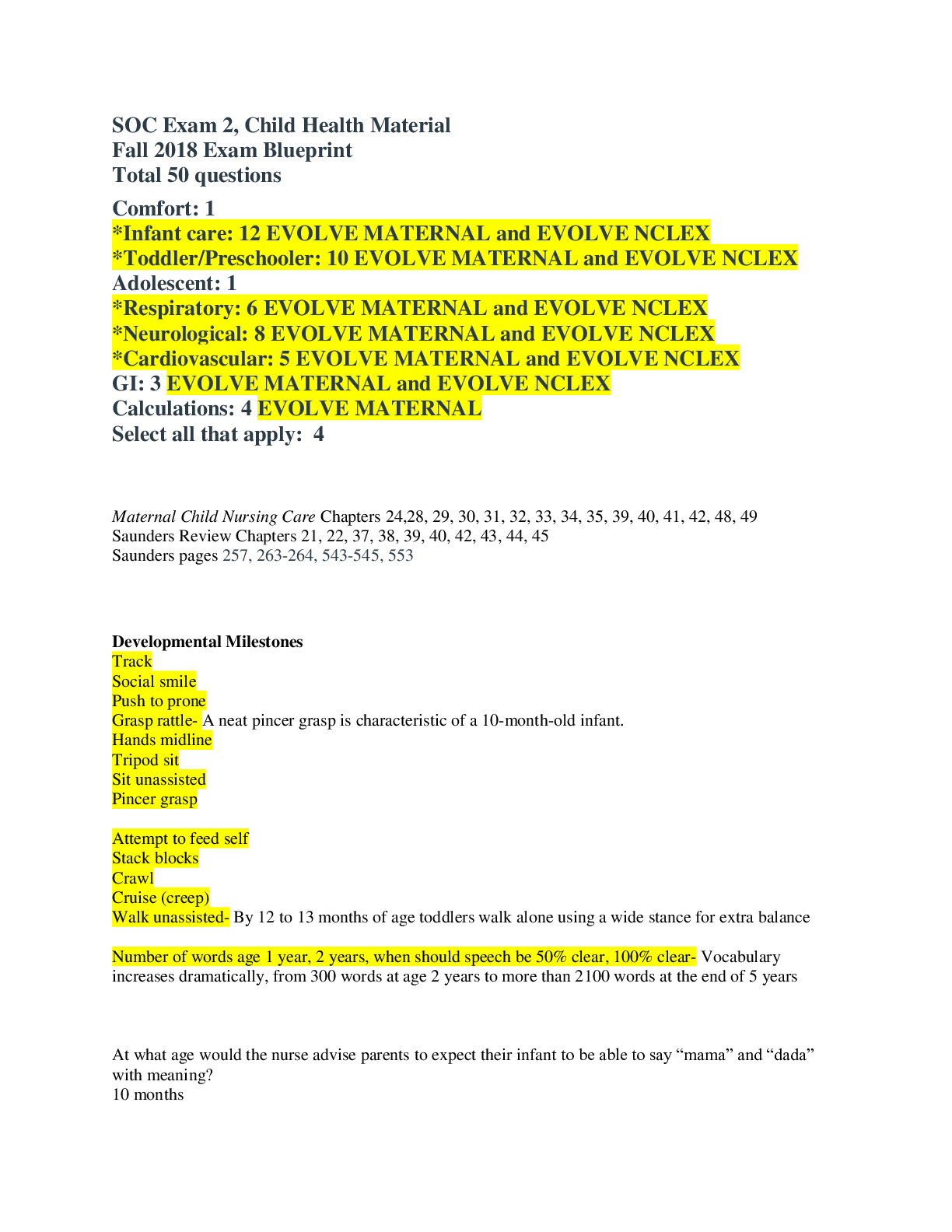
Buy this document to get the full access instantly
Instant Download Access after purchase
Add to cartInstant download
Reviews( 0 )
Document information
Connected school, study & course
About the document
Uploaded On
Jun 27, 2020
Number of pages
39
Written in
Additional information
This document has been written for:
Uploaded
Jun 27, 2020
Downloads
0
Views
74



